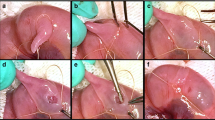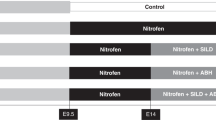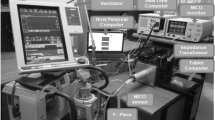Abstract
In the fetal rat, nitrofen induces congenital diaphragmatic hernia (CDH) and pulmonary vascular remodeling similar to what is observed in the human condition. Airway hyperactivity is common in infants with CDH and attributed to the ventilator-induced airway damage. The purpose of this study was to test the hypothesis that airway smooth muscle mechanical properties are altered in the nitrofen-induced CDH rat model. Lungs from nitrofen-exposed fetuses with hernias (CDH) or intact diaphragm (nitrofen) and untreated fetuses (control) were studied on gestation d 21. The left intrapulmonary artery and bronchi were removed and mounted on a wire myograph, and lung expression, content, and immunolocalization of cyclooxygenases COX-1 and COX-2 were evaluated. Pulmonary artery muscle in the CDH group had significantly (p < 0.01) lower force generation compared with control and nitrofen groups. In contrast, the same generation bronchial smooth muscle of the CDH and nitrofen groups developed higher force compared with control. Whereas no differences were found in endothelium-dependent pulmonary vascular muscle tone, the epithelium-dependent airway muscle relaxation was significantly decreased (p < 0.01) in the CDH and nitrofen groups. The lung mRNA levels of COX-1 and COX-2 were increased in the CDH and nitrofen groups. COX-1 vascular and airway immunostaining, as well as COX-1 and COX-2 lung protein content, were increased in the CDH group. This is the first report of airway smooth muscle abnormalities in the nitrofen-induced fetal rat model of CDH. We speculate that congenital airway muscle changes may be present in the human form of this disease.
Similar content being viewed by others
Log in or create a free account to read this content
Gain free access to this article, as well as selected content from this journal and more on nature.com
or
Abbreviations
- CDH:
-
congenital diaphragmatic hernia
- COX:
-
cyclooxygenase
- GAPDH:
-
glyceraldehyde 3-phosphate dehydrogenase
- ACh:
-
acetylcholine
- SNP:
-
sodium nitroprusside
References
Hazebroek FW, Tibboel D, Bos AP, Pattenier AW, Madern GC, Bergmeijer JH, Molenaar JC 1988 Congenital diaphragmatic hernia: impact of preoperative stabilization. A prospective pilot study in 13 patients. J Pediatr Surg 23: 1139–1146
Walsh MC, Stork EK 2001 Persistent pulmonary hypertension of the newborn. Rational therapy based on pathophysiology. Clin Perinatol 28: 609–627
Muratore CS, Kharasch V, Lund DP, Sheils C, Friedman S, Brown C, Utter S, Jaksic T, Wilson JM 2001 Pulmonary morbidity in 100 survivors of congenital diaphragmatic hernia monitored in a multidisciplinary clinic. J Pediatr Surg 36: 133–140
Broughton AR, Thibeault DW, Mabry SM, Truog WE 1998 Airway muscle in infants with congenital diaphragmatic hernia: response to treatment. J Pediatr Surg 33: 1471–1475
Greer JJ, Allan DW, Babiuk RP, Lemke RP 2000 Recent advances in understanding the pathogenesis of nitrofen-induced congenital diaphragmatic hernia. Pediatr Pulmonol 29: 394–399
Greer JJ, Cote D, Allan DW, Zhang W, Babiuk RP, Ly L, Lemke RP, Bagnall K 2000 Structure of the primordial diaphragm and defects associated with nitrofen-induced CDH. J Appl Physiol 89: 2123–2129
Coppola CP, Gosche JR 2001 Oxygen-induced vasodilation is blunted in pulmonary arterioles from fetal rats with nitrofen-induced congenital diaphragmatic hernia. J Pediatr Surg 36: 593–597
Guilbert TW, Gebb SA, Shannon JM 2000 Lung hypoplasia in the nitrofen model of congenital diaphragmatic hernia occurs early in development. Am J Physiol Lung Cell Mol Physiol 279: L1159–L1171
Keijzer R, Liu J, Deimling J, Tibboel D, Post M 2000 Dual-hit hypothesis explains pulmonary hypoplasia in the nitrofen model of congenital diaphragmatic hernia. Am J Pathol 156: 1299–1306
Nakayama DK, Motoyama EK, Evans R, Hannakan C 1992 Relation between arterial hypoxemia and plasma eicosanoids in neonates with congenital diaphragmatic hernia. J Surg Res 53: 615–620
Oue T, Shima H, Guarino N, Puri P 2000 Antenatal dexamethasone administration increases fetal lung DNA synthesis and RNA and protein content in nitrofen-induced congenital diaphragmatic hernia in rats. Pediatr Res 48: 789–793
Belik J, Karpinka B, Hart DA 2000 Pulmonary and systemic vascular tissue collagen, growth factor, and cytokine gene expression in the rabbit. Can J Physiol Pharmacol 78: 400–406
Weinberger B, Weiss K, Heck DE, Laskin DL, Laskin JD 2001 Pharmacologic therapy of persistent pulmonary hypertension of the newborn. Pharmacol Ther 89: 67–79
Au-Fliegner M, Salami S, Gosche JR 1998 Pulmonary arterioles from rats with congenital diaphragmatic hernias are hypoplastic but not hyperresponsive. J Pediatr Surg 33: 1366–1370
Coppola CP, Au-Fliegner M, Gosche JR 1998 Endothelin-1 pulmonary vasoconstriction in rats with diaphragmatic hernia. J Surg Res 76: 74–78
Newell MA, Au-Fliegner M, Coppola CP, Gosche JR 1998 Hypoxic pulmonary vasoconstriction is impaired in rats with nitrofen-induced congenital diaphragmatic hernia. J Pediatr Surg 33: 1358–1362
Belik J, Halayko AJ, Rao K, Stephens NL 1993 Fetal ductus arteriosus ligation: pulmonary vascular smooth muscle biochemical and mechanical changes. Circ Res 72: 588–596
Bos AP, Tibboel D, Hazebroek FW, Stijnen T, Molenaar JC 1990 Congenital diaphragmatic hernia: impact of prostanoids in the perioperative period. Arch Dis Child 65: 994–995
Ford WD, James MJ, Walsh JA 1984 Congenital diaphragmatic hernia: association between pulmonary vascular resistance and plasma thromboxane concentrations. Arch Dis Child 59: 143–146
Fortner CN, Breyer RM, Paul RJ 2001 EP2 receptors mediate airway relaxation to substance P, ATP, and PGE2 . Am J Physiol Lung Cell Mol Physiol 281: L469–L474
Kao J, Fortner CN, Liu LH, Shull GE, Paul RJ 1999 Ablation of the SERCA3 gene alters epithelium-dependent relaxation in mouse tracheal smooth muscle. Am J Physiol 277: L264–L270
McGrogan I, Daniel EE 1996 Release and actions of inhibitory prostaglandins from canine tracheal epithelium. Can J Physiol Pharmacol 74: 1055–1060
Tenbrinck R, Gaillard JL, Tibboel D, Kluth D, Lachmann B, Molenaar JC 1992 Pulmonary vascular abnormalities in experimentally induced congenital diaphragmatic hernia in rats. J Pediatr Surg 27: 862–865
Hill AC, Adzick NS, Stevens MB, Mori H, Husseini W, Heymann MA 1994 Fetal lamb pulmonary hypoplasia: pulmonary vascular and myocardial abnormalities. Ann Thorac Surg 57: 946–951
Lipsett J, Cool JC, Runciman SC, Ford WD, Parsons DW, Kennedy JD, Martin AJ 2000 Effect of immediate versus slow intrauterine reduction of congenital diaphragmatic hernia on lung development in the sheep: a morphometric analysis of term pulmonary structure and maturity. Pediatr Pulmonol 30: 228–240
Irish MS, Glick PL, Russell J, Kapur P, Bambini DA, Holm BA, Steinhorn RH 1998 Contractile properties of intralobar pulmonary arteries and veins in the fetal lamb model of congenital diaphragmatic hernia. J Pediatr Surg 33: 921–928
O'Toole SJ, Karamanoukian HL, Irish MS, Sharma A, Holm BA, Glick PL 1997 Tracheal ligation: the dark side of in utero congenital diaphragmatic hernia treatment. J Pediatr Surg 32: 407–410
Alfonso LF, Arnaiz A, Alvarez FJ, Qi B, Diez-Pardo JA, Vals-i-Soler A, Tovar JA 1996 Lung hypoplasia and surfactant system immaturity induced in the fetal rat by prenatal exposure to nitrofen. Biol Neonate 69: 94–100
Chen J, MacGowan A, Ward S, Bavik C, Greer J 2002 Activation of the retinoid response element is inhibited in an animal model of congenital diaphragmatic hernia. Biol Neonate ( in press)
Greer JJ, Mey J, Babiuk RP, Lugston R 2002 Retinal dehydrogenase is inhibited by compounds that induce congenital diaphragmatic hernia. Pediatr Res 51: 333A( abstr)
Sirsjo A, Gidlof AC, Olsson A, Torma H, Ares M, Kleinert H, Forstermann U, Hansson GK 2000 Retinoic acid inhibits nitric oxide synthase-2 expression through the retinoic acid receptor-α. Biochem Biophys Res Commun 270: 846–851
Medhora MM 2000 Retinoic acid upregulates β(1)-integrin in vascular smooth muscle cells and alters adhesion to fibronectin. Am J Physiol Heart Circ Physiol 279: H382–H387
Wu GR, Jing S, Momma K, Nakanishi T 2001 The effect of vitamin A on contraction of the ductus arteriosus in fetal rat. Pediatr Res 49: 747–754
Author information
Authors and Affiliations
Corresponding author
Additional information
Supported by grants from the CIHR (J.B., S.D., J.J.G.) and March of Dimes (J.J.G.). S.D. and J.J.G. are Senior Scholars of the Alberta Heritage Foundation for Medical Research (AHFMR).
Rights and permissions
About this article
Cite this article
Belik, J., Davidge, S., Zhang, W. et al. Airway Smooth Muscle Changes in the Nitrofen-Induced Congenital Diaphragmatic Hernia Rat Model. Pediatr Res 53, 737–743 (2003). https://doi.org/10.1203/01.PDR.0000057986.74037.7B
Received:
Accepted:
Issue date:
DOI: https://doi.org/10.1203/01.PDR.0000057986.74037.7B
This article is cited by
-
Upregulation of S1P1 and Rac1 receptors in the pulmonary vasculature of nitrofen-induced congenital diaphragmatic hernia
Pediatric Surgery International (2016)
-
Decreased apelin and apelin-receptor expression in the pulmonary vasculature of nitrofen-induced congenital diaphragmatic hernia
Pediatric Surgery International (2014)
-
Exploiting mechanical stimuli to rescue growth of the hypoplastic lung
Pediatric Surgery International (2007)



